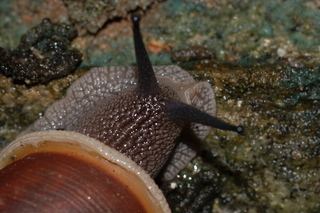Classification
Domain:
Eukarya
Kingdom:
Animalia
Phylum:
Mollusca
Class:
Gastropoda
Order:
Stylommatophora
Family:
Polygyridae
Genus:
Patera
Species
: Patera clarki
Description of Classification
Eukarya:
Being one of three domains, this domain is the only one with a
body structure containing true membrane bound nuclei and
membrane bound organelles (Hickman et
al., 2011).
Animalia: A group of multicellular organisms including invertebrates and vertebrates (Hickman et al., 2011). This group
is separated from the other multicellular Kingdoms Fungi and Plantae by the fact that they lack cell walls to protect the cells, and do not have chloroplasts to u ndergo cellular respiration. They
instead have mitochondria to produce a form of energy.
ndergo cellular respiration. They
instead have mitochondria to produce a form of energy.
Mollusca: Comes from the latin work molluscus meaning soft, due to this phylum being known for having soft bodies being covered with a calcium carbonate shell (Hickman et al., 2011). Mollusca are triploblastic coelomates meaning they have a mesoderm, ectoderm, and an endoderm. Ectoderm refers to the outer layer of tissue, endoderm refers to the very inner layer of tissue, and mesoderm refers to the middle layer of tissue. Within the mesoderm lies the coelom, which is a fluid filled cavity.
Gastropoda: This Class is known as the "stomach foots," which comes from the Greek gastér meaning stomach and podos meaning foot. This class ranges from terrestrial air breathers to marine gill users containing about 70,000 living species (Hickman et al., 2011).
Stylommatophora: This order is strictly terrestrial, including land snails and slugs, and has adaptations because of this (Barker, 2004). They appear in mostly damp areas like forests or in arid areas (Barker, 2004). Another noticeable trait is that their shell length is generally shorter than most, leaving a lot of their soft body exposed (Barker, 2004). Members of Stylommatophora have cleidoic eggs; a cleidoic egg is an egg having a shell around the embryo to protect it from the environment. Stylommantophora is a group characterized with embryos having direct development (Wilbur, 1984).
Polygyridae: This family is the most widely spread in North America, from Canada to all the way to Mexico, including a majority of the United States (Pilsbry, 1940). They are known for having three or four teeth; the outer lip tooth has an upward extension parallel to the lip edges (Pilsbry, 1940).
Patera:
Species who are included in this Genus have a single tooth in
their main shell opening and have no holes purposely in the
shell (Eol.org, 2012).
Patera clarki:
Patera is latin for saucer and it is named because of
the sauce-shaped shell (Eol.org, 2012).
The spirals of the shell are closely coiled and its average
height is 10.5mm and has a diameter of 15mm (Pilsbry,
1940)